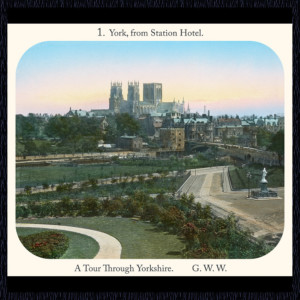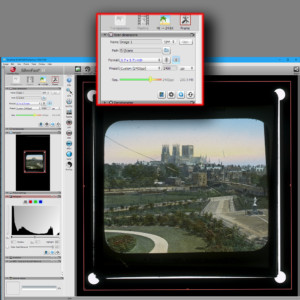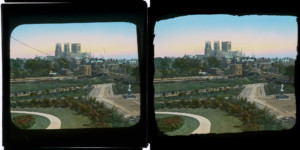 Some sharp-eyed magic lantern ephemera collectors have noticed that the 5″x4″ transparencies we produce from digital files might very well be handy to reproduce lantern slides.
Some sharp-eyed magic lantern ephemera collectors have noticed that the 5″x4″ transparencies we produce from digital files might very well be handy to reproduce lantern slides.
And indeed they would be correct.
Useful for duplicating valuable original slides or restoration of damaged slides, the process is reasonably easy, especially for British standard 3¼” x 3¼” and American standard 3¼” x 4″ slides.
Firstly, you need to create a digital copy of the lantern slide and it is perhaps easiest with a flat bed scanner that has a large format transparency scanning capability, such as the Epson Perfection V700 or V800 series of scanners.
The sharpest scanning area is central on the width, so don’t place the plate in the corner like you would do with a piece of A4 paper.
If you are going to be scanning several slides then you might like to make a cardboard mask to make positioning quick and accurate. This card mask saves time making repeated preview scans – fix your settings and simply swap originals and hit the scan button – and also blocks extraneous light which can degrade image contrast.


The scanning settings can often be infuriatingly obtuse – the final scan need to be something in the order of 6,000 pixels square.
The simple way is to set your scanner at 1800 or 2400dpi and do a preview, adjusting the scanning area to your slide.
It is important that you include the whole lantern slide glass area (not just the image), and a bit more.
Once you have made the scan you can do your image repair or tone/colour correction.
Make sure that the edges of the original lantern slide glass can be seen – although we will crop this excess off, we use this as reference to scale to an accurate 3¼” x 3¼”.
Save the image in JPEG format (level 10 or ‘high’ quality) and proceed to ordering on this website here: 5×4 transparencies from digital images
The 5″x4″ transparency you will receive back will have your image surrounded by a cut-to line. Simply trim to this and mount in your normal way with cover glasses, masks and passe-partout etc.
The alternative to scanning is to use a high quality digital camera with the slide on a light box.
The latest top of the line Nikon and Canon cameras should be OK but note that none achieve 6000px x 6000px in resolution so, all things being equal, won’t match flat bed scanning.
The illumination is tricky – most ‘daylight’ quality fluorescent tube or LED boxes don’t produce photographic quality spectrum, and therefore you may find a true daylight illumination solution gives better colour fidelity.

